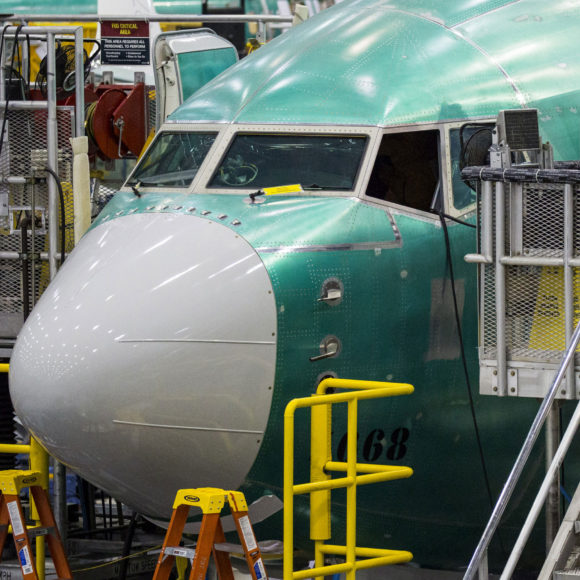Boeing Co. has begun carefully mapping out the steps to ease its 737 Max back into commercial service once regulators lift a global grounding for its best-selling jetliner.
The Chicago-based planemaker is planning the Max’s comeback with airlines in a series of meetings it’s been holding from Miami to Moscow, Boeing Chief Executive Officer Dennis Muilenburg told the Bernstein Strategic Decisions Conference on Wednesday.
But the chief executive of a global airline association offered a cautious assessment of when airworthiness authorities might give the Max a clean bill of health. Flights aren’t expected to resume for at least 10 to 12 weeks, Alexandre de Juniac, chief executive officer of the International Air Transport Association said on a call with reporters.
“We are preparing a meeting between regulators, the aircraft manufacturer and the operators to make an assessment of the situation,” De Juniac said. “But it is not in our hands. It’s in the hands of regulators.”
Boeing shares dipped 1.3% to $350.39 at 9:59 a.m. in New York. Through Tuesday, the stock has tumbled 16 percent since the March 10 crash of an Ethiopian Airlines jetliner.
‘Disciplined’ Comeback
Muilenburg is navigating one of the worst crises in Boeing’s 103-year history after regulators grounded the 737 Max, the company’s largest source of profit, following two fatal accidents that killed 346 people.
The Boeing CEO described a “disciplined” schedule that would start with Boeing teams helping to take the nearly 500 parked 737 jets out of storage. That total includes about 100 newly built Max that can’t be delivered until the grounding is lifted. They are stashed around the Seattle area and on a sprawling Boeing maintenance base in San Antonio, Texas. The planemaker has two other sites it could tap if needed, Muilenburg said.
Boeing doesn’t plan to increase the tempo at its main 737 factory — nor reinstate its financial forecast — until it’s clear that its supply-chain is healthy and moving in sync, Muilenburg said. Boeing suspended its outlook and share repurchases when regulators halted commercial flights in March.
The planemaker has been working to reassure travelers, pilots and regulators of its engineering prowess and commitment to safety after an obscure software system, called MCAS, was linked to two crashes. The company also faces a criminal probe and civil inquires from the U.S. Congress and the Securities and Exchange Commission for its role in the accidents and close ties to federal regulators.
Separate Reviews
Boeing has largely completed work on a redesigned version, but has yet to submit the final paperwork to the Federal Aviation Administration. Muilenburg said he was encouraged by a one-day summit last week with counterparts at global airlines on the steps required to return the grounded Boeing jetliner to service, including the need for additional pilot training.
But at least one regulator has reaffirmed plans to do a separate, in-depth review. The European Union Aviation Safety Agency plans to examine the 737 Max’s entire flight control system, including the plane’s displays, alerts and air-data systems, as well as the aircraft’s autopilot function, EASA Director Patrick Ky wrote in a letter dated May 27 and seen by Bloomberg.
“The regulators aren’t on the same page,” De Juniac said in a phone interview. “Otherwise they’d have a similar time line, a similar set of measures.”
Airlines, regulators and Boeing will meet in five to seven weeks to try and set a common schedule for returning the Max to service and restoring trust in the plane, De Juniac said in the interview. While the location has yet to be confirmed, IATA would like to see a single regulator making the call on airworthiness to avoid “useless complexity and additional costs,” he said.
IATA represents some 290 airlines, or more than 80% of total air traffic. The group will hold its annual meeting in Seoul this weekend, in the biggest gathering of airline and plane-company executives since the Boeing tragedies in October and March.
July Return?
The three U.S. operators of the Max have dropped the jet from their flight schedules through early August, in line with the timeframe cited by De Juniac. Meanwhile, SpiceJet Ltd. said Boeing representatives told it the 737 Max should be back in the air by July, signaling a quicker return for the plane.
“The timeline communicated to us based on their experience is July — end of June basically,” SpiceJet’s Chief Financial Officer Kiran Koteshwar said in an interview. “We are expecting it to be July.”
Representatives for Boeing in India didn’t comment.
Was this article valuable?
Here are more articles you may enjoy.


 State Farm Sued Over Policies Backed by Distressed Insurer PHL
State Farm Sued Over Policies Backed by Distressed Insurer PHL  Toyota Unveils Concept LFA Supercar, and It’s Fully Electric
Toyota Unveils Concept LFA Supercar, and It’s Fully Electric  Verlan Files Subro Suit Against Georgia Chemical Plant After $20M Payout on Fire
Verlan Files Subro Suit Against Georgia Chemical Plant After $20M Payout on Fire  Abbott Presses Congress for Shield Over Preemie Baby Formula Litigation That Could Cost It Billions
Abbott Presses Congress for Shield Over Preemie Baby Formula Litigation That Could Cost It Billions 